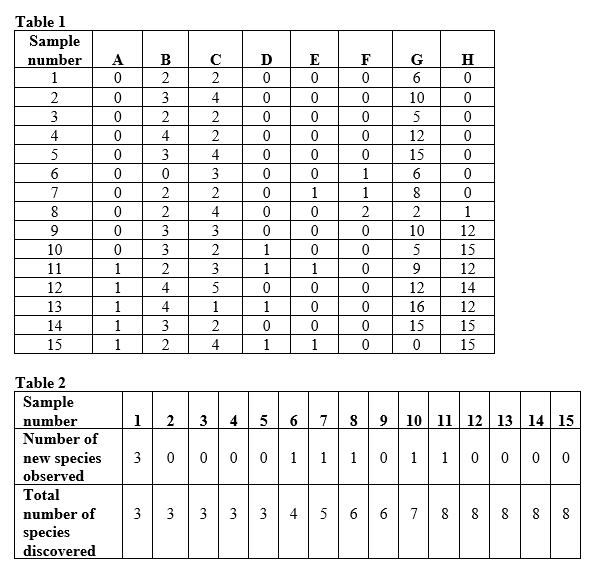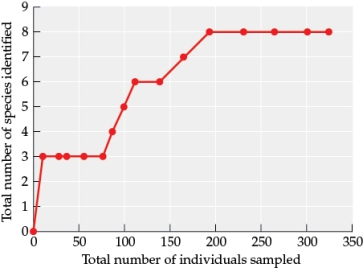Essay
Refer to the tables and figure.
 Figure 1
Figure 1
 Suppose you are researching an ecological community in a new study area. You divide your study area into quadrats and sample one quadrat a day to determine the species that occupy the area and how many individuals of these species are present. Assume that by the end of your sampling efforts, you have identified all of the species that occur in the study area. Use Table 1, Table 2, and Figure 1 to answer the following questions:
Suppose you are researching an ecological community in a new study area. You divide your study area into quadrats and sample one quadrat a day to determine the species that occupy the area and how many individuals of these species are present. Assume that by the end of your sampling efforts, you have identified all of the species that occur in the study area. Use Table 1, Table 2, and Figure 1 to answer the following questions:
a) In community ecology studies, what is the relationship that you graphed in Figure 1 commonly called?
b) Which species community measure did you plot on the y-axis of the graph?
c) What percentage of the total individuals did you have to sample before you identified all of the species in your study area?
d) How many quadrats did you have to sample before you identified all of the species in your study area?
Correct Answer:

Verified
a) Species accumulat...View Answer
Unlock this answer now
Get Access to more Verified Answers free of charge
Correct Answer:
Verified
View Answer
Unlock this answer now
Get Access to more Verified Answers free of charge
Q7: Refer to the figure.<br><img src="https://d2lvgg3v3hfg70.cloudfront.net/TBO1115/.jpg" alt="Refer to
Q8: Which conclusion was the primary finding of
Q9: How many total trophic levels are present
Q10: Which statement best describes the difference between
Q11: Refer to the table.<br>Table 9<br> <img src="https://d2lvgg3v3hfg70.cloudfront.net/TBO1115/.jpg"
Q13: Refer to the figure.<br><img src="https://d2lvgg3v3hfg70.cloudfront.net/TBO1115/.jpg" alt="Refer to
Q14: Menge and colleagues performed experiments in which
Q15: Alsterberg and colleagues showed that with ocean
Q16: Refer to the figure.<br><img src="https://d2lvgg3v3hfg70.cloudfront.net/TBO1115/.jpg" alt="Refer to
Q17: Which scenario is a competitive network?<br>Scenario I: